Let’s get ready to weeeeeeeeeave!!!! Today’s new fabric is a solid winner, with lots of color work potential. Inspired by the recent 2-float twill tumbling boxes, this pattern combines 3-floats over tabby squishy boxes, that create an amazing 3-layer fabric, thick, flat and bendy, with little bias. It draws up very small and evenly. The surface is flat, making this great for coasters and trivets. It would be great on cast iron, as it is thick yet not stiff.
I wove the first version in lavender and hydrangea alternating boxes. The color potential became clear after taking it off the loom, when the tabby-like section formed by the box centers was covered by the floats on the surface, forming a basketweave illusion.
For the second version, I highlighted the color-hiding and surface display by making a stairstep of alternating daffodil and tigerlily on the surface, with hidden white centers. It uses the same weaving pattern, with a different color threading.
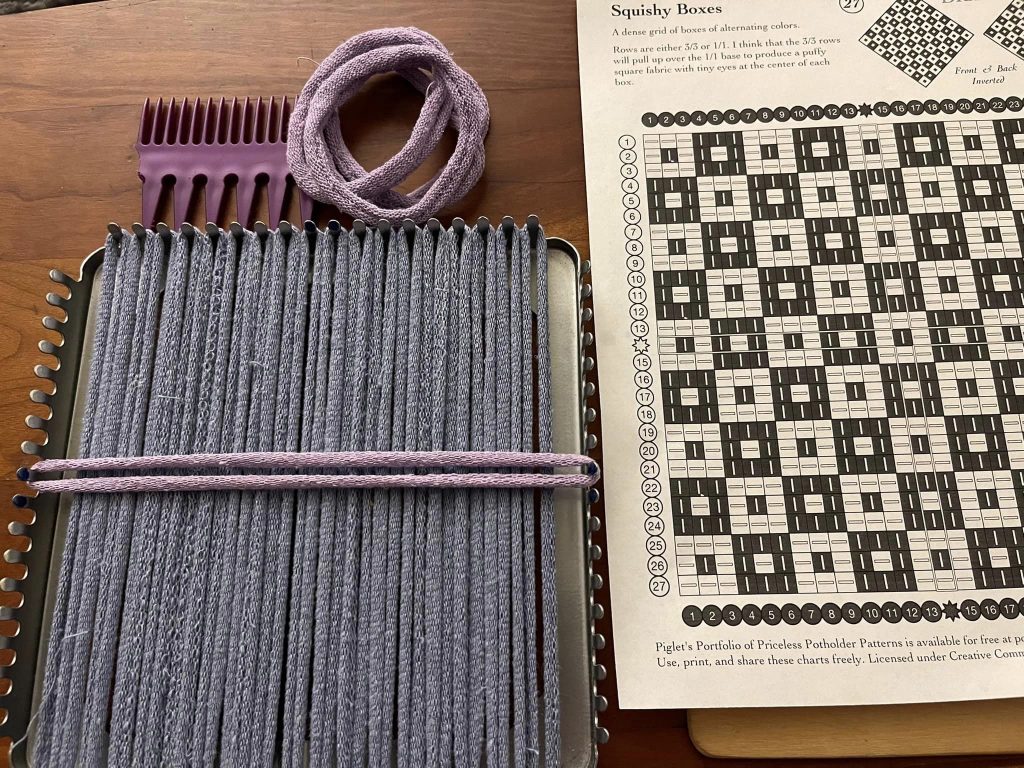
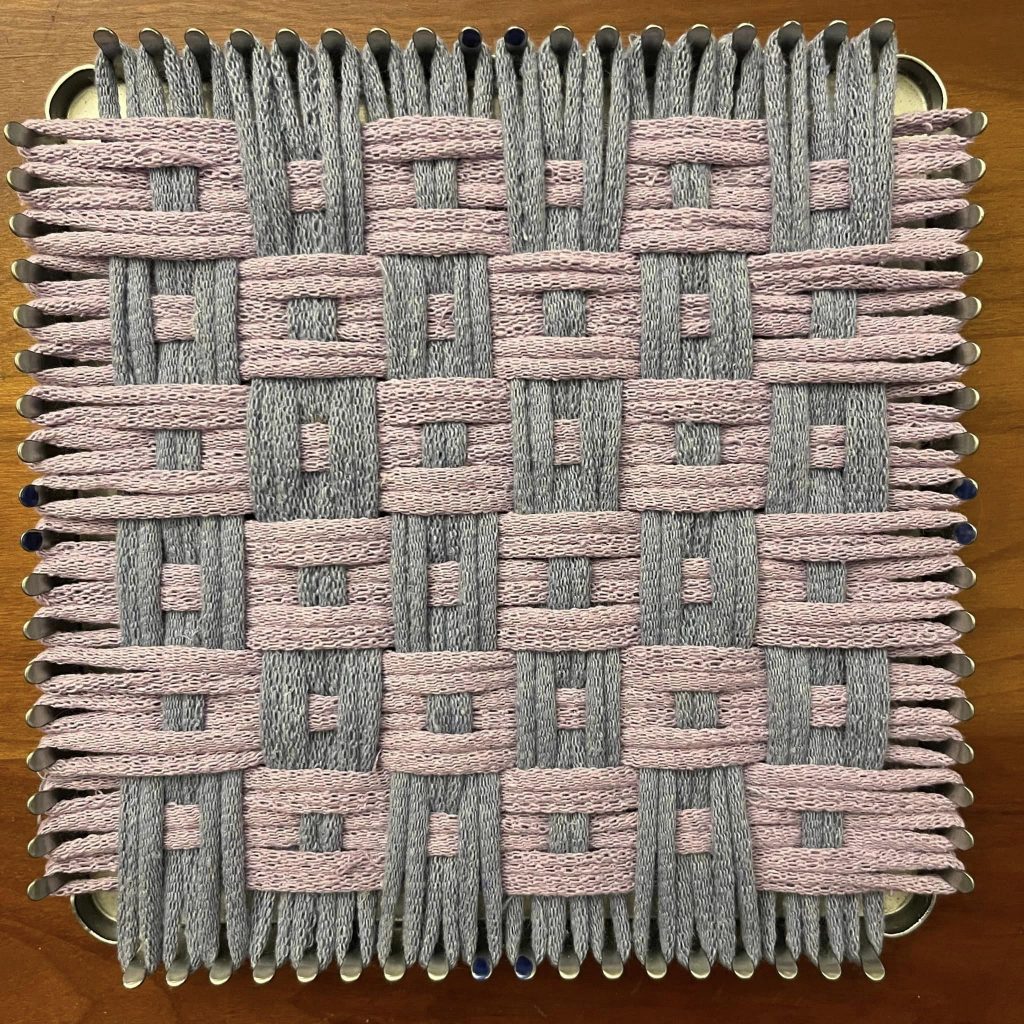

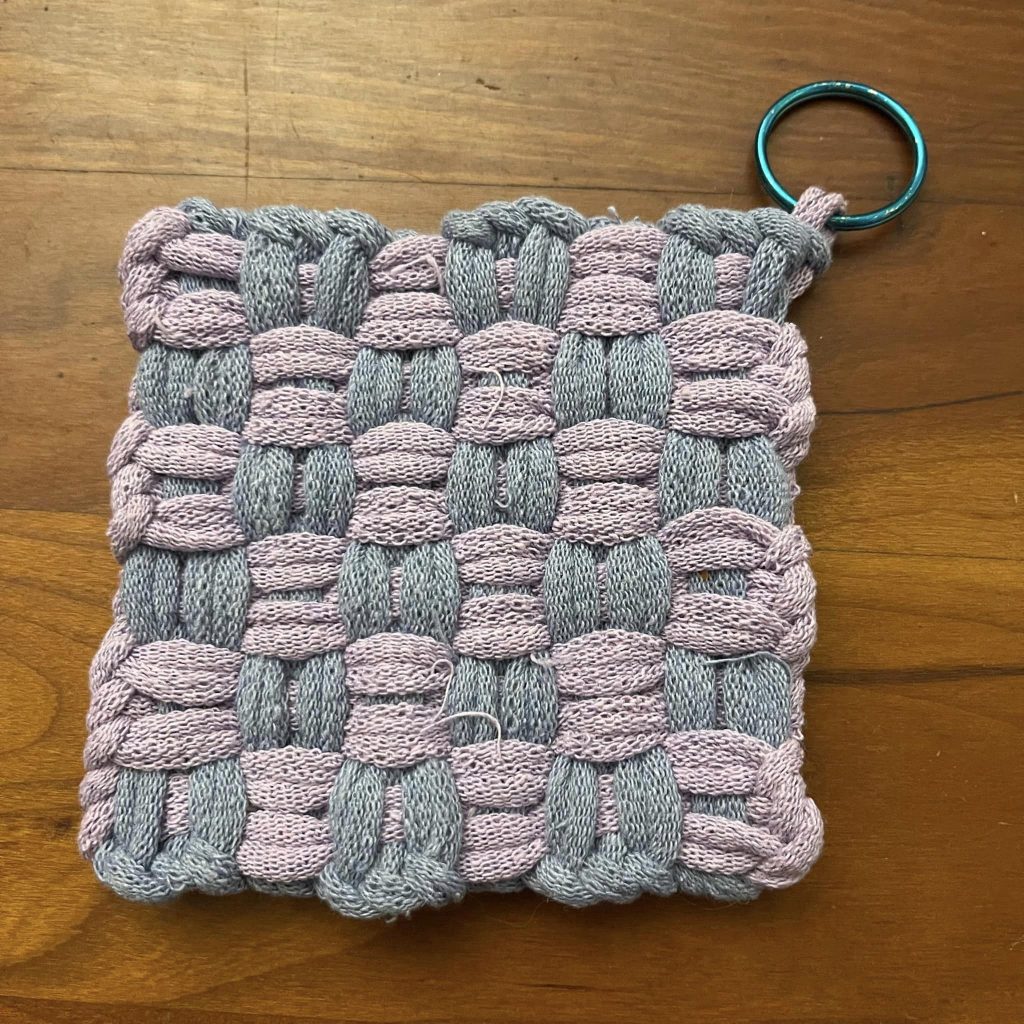




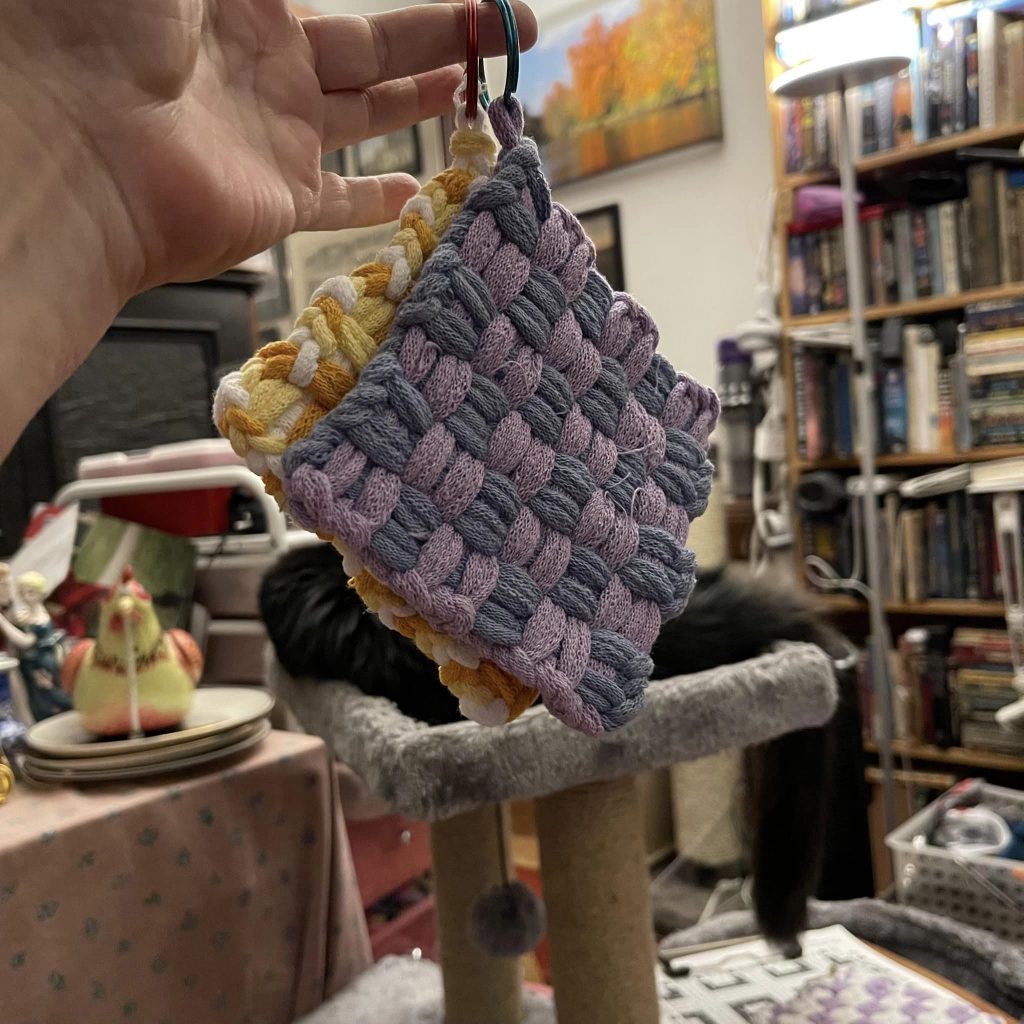

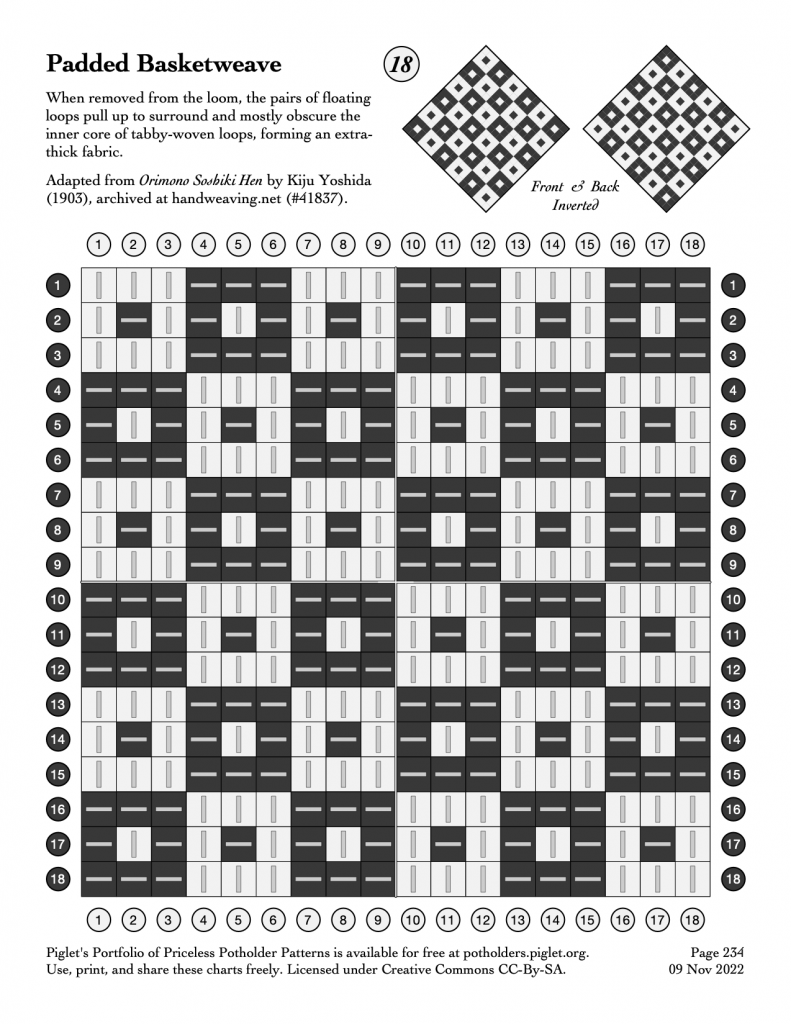



When you say “three-layer fabric”, do you mean that it’s necessary to weave this particular design using the 3-layer warp technique documented here? http://potholders.piglet.org/2021/10/3-layer-warping-a-tutorial/ — I assume the answer is “no” because this has twills and that page says you can only use it on tabby patterns, but that means the term “three-layer” is getting used more than one way and I don’t know all the ways.
Really, I’m asking 3 separate questions in my total confusion so let me break them down.
1. What exactly do you mean on this write-up when you say this produces a “three-layer fabric” if it is still made with just one loop per row and column? “Layer” to my novice brain implies stacking loops atop one another on the same pins to me and I don’t see that happening on this printed pattern or the video. Does layer mean something different to “folks that know”?
2. For this specific pattern (Padded Basketweave or Padded Basketweave Steps) will it come out right weaving in the “typical” order of operations (warp first, all the way across, then add weft in whatever order, for me usually top to bottom) or is there something different I’m supposed to do in terms of order of operations? Is this just a typical 36-loop design (for a small loom, not the pro) in the end or are there additional loops somewhere? Do I just make this the same way I’ve made everything else so far (I’ve done fish scales, three-color fish scales, square double spiral, pinwheels, twill diamond, and several comparable others) or is there something different about this one in terms of technique?
3. Is there anything in the printed patterns _in general_, beyond this particular example, that tells you specifically when you ought to use a different order of operations applying the loops to the pins (like the “three-layer warp” one I linked above) other than the default mode of stringing the warp all the way across and then doing the weft in any order as long as it follows the pattern? The 3 layer warp tutorial says it’s only for tabby with no twill, but beyond that – if the pattern doesn’t *say* to do anything new or different, can it just be assumed that the most basic technique will produce the correct result?
Michael — I’m sorry for any confusion. As with many crafts, some words and phrases get used in multiple ways, and there are multiple words to describe the same thing, so terminology is inconsistent.
As you noted, the “three-layer fabric” being referred to here has no relationship to the “three layer warping” technique described elsewhere.
1. The “three-layer fabric” being discussed here has an extra layer of thickness — meaning that the distance between your hand and the hot pan you’re holding is further than with a traditional weave.
In a typical woven potholder, at each point in the weave (or each square in the chart) there are two loops, one passing over the other. This one starts out the same, while it’s being woven, but when it is removed from the loom it scrunches up — becoming narrower in width, but significantly thicker. During this process, the loops “stack up” on top of each other more than they do in a regular weave.
For example, look at the above photos of the yellow-and-white potholder while on the loom — then look at what happens when it’s bound off and removed. The yellow loops slide over the white loops, so that on the front and the back you mostly just see yellow, and the white loops are hidden inside. That means that at each point in the weave (more or less) it seems like there are three loops — a yellow on the front, a white in the middle, and a yellow on the back. These are the three layers being referenced.
2. Yes, you can weave this design exactly like you do any others — warp the entire loom, and then weave in the weft in your preferred order. The “layering” process happens when the loops shrink in on themselves after you bind off.
Something similar happens with the various weaves grouped under the “Multilayer Twill” heading — you weave them as usual, but when they come off the loom they scrunch up to make an extra-thick weave in which some loops are hidden “inside” the fabric.
(The exception in the “Multilayer Twill” section is the “Double-Faced Twill”, which really is woven with two layers of weft — tricky in a different way.)
3. The same is true for essentially all of our charts — they’re all woven in the standard order: fully warped, then weft woven in, starting from whichever point you prefer.
The three-layer warping technique is an outlier — an unusual trick that some people use to speed up tabby weaves — and not representative of a general “out of order” approach to other weaves.
Thank you so much, Matthew, and please don’t apologize. I’m a software developer and a very left-brained, literally-reading person, and my arts-and-crafts skills are slim to none but occasionally I will get interested in something like this and try to get into it without much background knowledge of the world it operates in.
My potholder story is that my grandmother (rest her soul) gave me a 7″ loom and some bags of loops when I was in elementary school, and I did one tabby weave potholder and didn’t know how to crochet it off the loom and neither did my parents, and I kept forgetting to ask my grandmother, and eventually it was boxed up, loom, loops, and all, with other unused toys and forgotten about until two months ago, now age 34, I found it while cleaning up, still stretched across the pins. Thanks to the modern miracle of YouTube I was able to figure out how to take the now-twenty-year-old potholder off the loom and I just decided that now that I knew how, I wanted to start doing them again. I’ve been dealing with some personal stress and life changes and whenever I’m in that kind of a funk, I tend to pick something that I can “do with my hands” like this and do it obsessively as a distraction… so I’ve been buying loops on Amazon and I figure I’ve done at least 32-35 potholders in the last 6 weeks since figuring it out.
Finding your book of patterns has been a game changer because I was getting bored with simple tabby and I don’t have the creative brain to come up with my own different designs. I skim the pdf for things I want to try and print off three or four at a time and do them in the evenings after work and it has been so much fun and so relaxing. I can’t thank you enough for what I know was not just hours but days and weeks of work maintaining all this material and making it available for free.
Along the lines of unusual tricks and outliers – it would be cool to add an appendix to the guides someday and cover “unusual” weaving techniques such as the three-layer warp, but kind of collate them together if there is more than one strange technique like that and discuss when it’s a good idea to use them. Besides what’s in your books, the only thing I’ve done that was “outside the box” so far is that I was able to follow a YouTube tutorial (sadly, not one from you guys), for making potholders that come out looking like four solid color triangles all pointing in towards the center. I’m sure you already know what I’m talking about, but it’s the one where you start with two warp and two weft strings dead center on the loom and then do a sort of right angle twist crossover move that results in both ends of the loop ending up on the same face of the loom each time you go around the circle. I would never have been able to think up something like that, and ever since discovering that this was “a thing”, I’ve been curious how many other “things” like it there are out there that I just don’t know about yet. You folks seem like the perfect ones to take on the challenge of discovering and documenting those so I’ll just throw that out there for your spare time 😀
Again, thank you for your time and your effort and your willingness to just put this out there for everyone to benefit from at great expense to yourselves.
Michael — thank you for your kind words, and for sharing your story; I’m glad that this miniature form of weaving has provided a connection to your childhood and a chance to decompress from life’s many challenges.
I’m not sure we’re up for writing a complete guide to all of the “unusual” things you can do with a loom, but we will try to keep exploring a few of them from time to time.
The technique where loops “twist” around each other to change direction is often labeled with the term “clasped weave” and we’ve recently shown a few examples of this in the tri-color and American flag posts..
If you want to find more “outside the box” ideas, you might take a look at the book “Potholder Loom Weaving” by Noreen Crone-Findlay. (About $25 on Amazon.) I haven’t read it, but it seems to cover a bunch of interesting things you can do beyond woven rectangles, using both loops and yarn on the same peg loom you already have.
Other “non-standard” things you can do include treating each stand of the warp separately, rather than handling the warp loops as an indivisible unit; we have a few examples of this kind of “split-loop” technique in our collection but other people have covered in greater depth, including the book “Artful Twill Weaving with Loops” by Linda Lutomski. (About $25 on Amazon.)
There are even more adventurous weaves that include twisting warp or weft fibers over one another while weaving; we have a single example of this charted (“Gauze”) but again there are other folks who have spent more time coming up with new designs using this technique.
And unsurprisingly there are numerous ways of binding off the potholders, or stitching them together to make placemats or table runners or baskets or pillow shams, etc… If you use Facebook, check out the “Potholder People” group for additional inspiration.
Have fun exploring!